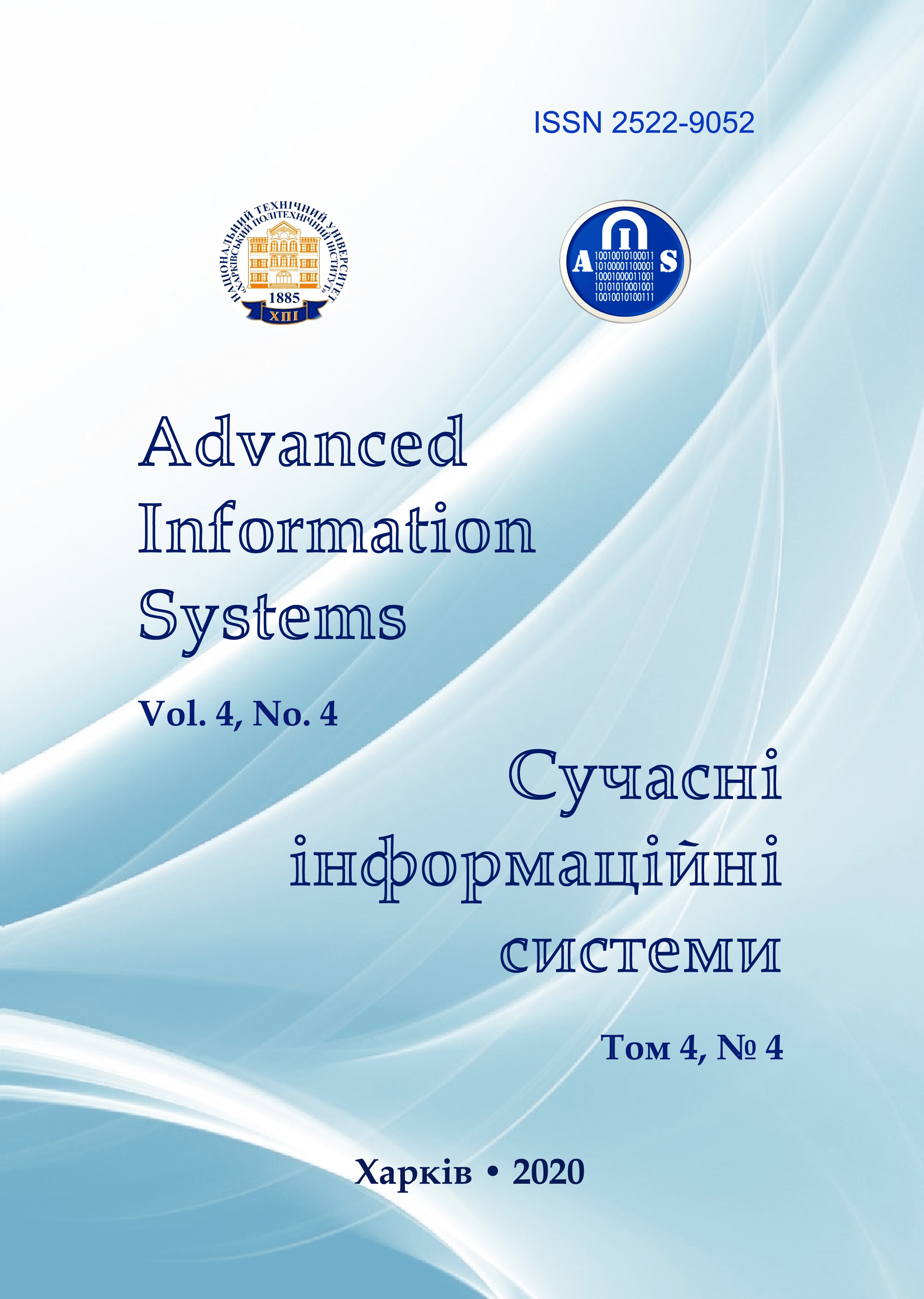KNOWLEDGE-ORIENTED INFORMATION TECHNOLOGY TO VARIABILITY MANAGEMENT AT THE DOMAIN ANALYSIS STAGE IN SOFTWARE DEVELOPMENT
Main Article Content
Abstract
The subject matter of this paper is a research of issues related to the variability management at the stage of domain analysis (DA) in the full life cycle (FLC) of software products line (SPL). The main goal of this research work is the elaboration of a new knowledge-based information technology to support a variability management in DA as a most complex and weak-formalized stage in FLC of SPL. In order to reach this goal the following tasks were formulated and resolved: to analyze the variability issues in FLC on the example of the modern agile-development approach - in the Scrum-methodology; to study how the methods of knowledge handling can be used to support some users and domain-experts activities within the DA phase with respect to software variability modeling; to make the motivated choice of the suitable CASE-tools to elaborate an appropriate IT solution to support the knowledge-oriented approach to DA; to present this IT-solution in a structured form, to consider some its implementation issues, and to discuss the first testing results. The methods used in this research are: domain-driven design approach to software development, repertory grids method and ontologies for expert’s knowledge handling, IDEF0 notation for specification of the proposed IT solution, feature-oriented domain analysis (FODA) for variability modeling. Conclusions: the results of this research shown that the special attention has to be paid to the DA in a FLC, especially with usage of knowledge-based methods. To perform this process in an effective way the repertory grids method is motivated chosen and analyzed. To support the usage of this method in DA the proposal is made to elaborate the special IT-solution using some already available CASE-tools. The essentials functionality features of two such systems: GridSuite and SOVA (Semantical and Ontological Variability Analysis) are considered, and basing on this result, the integrated IT-solution is elaborated and presented in form of the IDEF0 diagram. Finally, the main technological facets of these tools installation are studied and tested, and the test-case to show the possibility to generate the FODA-variability model for the “Smart-Home” application domain is provided.
Article Details
References
Sommerville, I. (2015), Software Engineering, 10th edition, Addison-Wesley, NY.
Pohl, Klaus, Böckle, Günter, van der Linden, Frank J. (2005), Software Product Line Engineering: Foundations, Principles, and Techniques, Springer, 467 p.
Lavrishcheva, K. M., Koval, G.I., Babenko, L.P., Slabospytska, O.O. and Ignatenko, P.P. (2011), New theoretical bases of technology production of software systems families in the context of generating programming: monograph, Institute Program Systems, NAS Ukraine, Кyiv, 277 p. (in Ukrainian).
Tiihonen, Juha, Raatikainen, Mikko, Myllärniemi, Varvana and Männistö, Tomi (2016), “Carrying Ideas from Knowledge-based Configuration to Software Product Lines”, Proceedings of the 15th International Conference on Software Reuse, Cyprus, June 5-7, , pp. 55–62.
Methods of knowledge acquisition automatization in expert systems: classification, current state, comparative analysis, International scientific-practical journal “Software products and systems”, available to: http://www.swsys.ru/index.php? page= article &id=1187&lang=.docs (in Russian).
Capilla, R., Bosch, J. and Kang, K. (2013), Systems and Software Variability Management, Springer, Berlin.
Karagiannis, D., Mayr, H.C. and Mylopoulos, J. (2016), Domain-Specific Conceptual Modeling: Concepts, Methods and Tools, Springer, Berlin.
Tune, N. and Millet, S. (2015), Patterns, Principles And Practices Of Domain-driven Design, 1st ed., John Wiley & Sons.
Tkachuk M., Gamzaev R., Martinkus I., Sokol, V. and Tovstokorenko, O. (2018), “Towards Effectiveness Assessment of Domain Modelling Methods and Tools in Software Product Lines Development”, Enterprise Modelling and Information Systems Architectures – International Journal of Conceptual Modeling, Vol. 13, Germany, pp. 190-206.
Gamzayev, R.O., Tkachuk, M.V. and Shevkoplias D.O. (2020), “Handling of Expert Knowledge in Software Product Lines Development with Usage of Repertory Grids Method”, Bulletin of the V.N. Karazin Kharkiv National University: ‘Mathematical Modeling. Information Technologies. Automated Control Systems, No. 47, pp. 13-24.
Eleutério, J. (2017), A Comparative Study of Dynamic Software Product Line Solutions for Building Self-Adaptive Systems, 30 p.
Kumar, Manish and Dwivedi, R.K. (2020), Applicability of Scrum Methods in Software Development Process, available at: https://ssrn.com/abstract=3610759 or http://dx.doi.org/10.2139/ssrn.3610759.
Sangeeta, D. and Seok-Won, L. (2015), From Requirements Elicitation to Variability Analysis Using Repertory Grid: A Cognitive Approach, Proceeding of RE, Ottawa, ON, Canada, pp. 46-55.
(2020), GridSuite, Repertory Grid Software, 2003-2020, available at: https://www.gridsuite.de/45623/41431.html.
Fromm, M. (2017), Manual for GridSuite 4 and 4+, 54 p.
Thorsten, Berger, Marsha, Chechik, Timo, Kehrer and Manuel, Wimmer (2019), “Software evolution in time and space: unifying version and variability management”, Report from Dagstuhl Seminar, 19191, May 5-10, p. 30.
Itzik, N. and Reinhartz-Berger, I. (2014), “SOVA - A Tool for Semantic and Ontological Variability Analysis”, CAiSE’14 Forum, CEUR Workshop Proceedings 1164, pp. 177-184.
Lavrishcheva, K. M. (2008), Software Engineering, IPU, Kyiv, 319 p., available at:
URL: http://csc.knu.ua/uk/library/books/lavrishcheva-6.pdf (in Ukrainian).
Lucassen, G., Dalpiaz, F., Martijn, J. and Brinkkemper S. (2016), “Improving Agile Requirements: the Quality User Story Framework and Tool”, Requirements Engineering, Vol. 21 pp. 383-403.
(2020), Protégé System, Stanford University, available at: https://protege.stanford.edu/products.php#desktop-protege.
(2020), Simple Ontology Visualization API, Jean-Philippe Lang, 2006-2013, available at:
https://kask.eti.pg.gda.pl/redmine/projects/sova/wiki/Main_Page.
(2020), SOVA-Visualization symbols, Appendix C, available at: https://protegewiki.stanford.edu/wiki/File:SOVA-Symbols.pdf.
